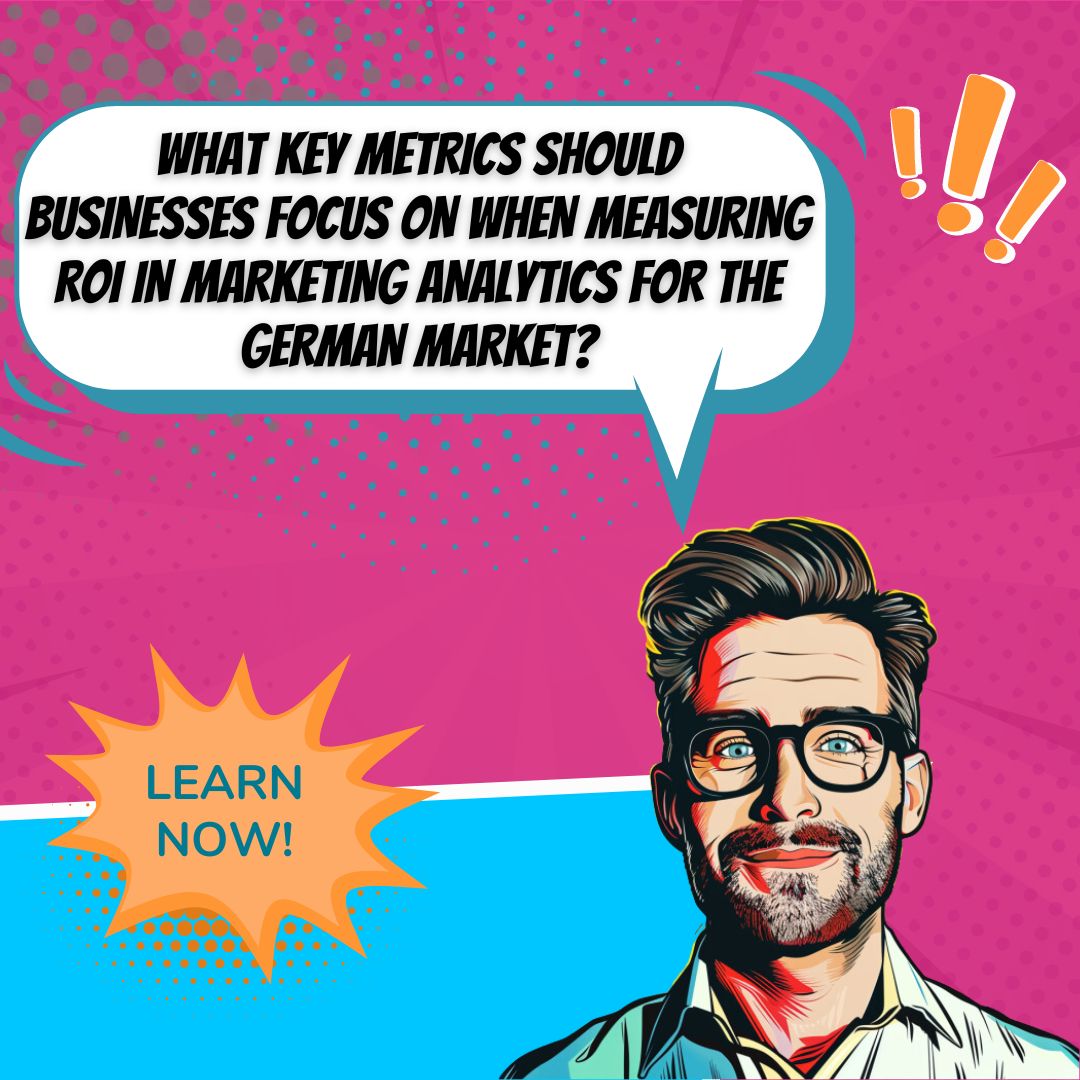Key Takeaways
✅ Data-driven decision-making is your new best friend in the German market. It's all about crunching the numbers to outsmart the competition. Did you know that businesses utilizing analytics have seen up to a 5-10% increase in profit? This isn't just about following trends; it's about setting new benchmarks for success.
✅ Customization and personalization are the names of the game when it comes to captivating German customers. By diving into the data, you can tailor your approach and see as much as a 20% surge in sales. Want to make every customer feel like the VIP of your brand? This is how.
✅ Technology and analytics go hand in hand, much like pretzels with beer. Embrace this dynamic duo, and watch your digital engagement soar by up to 15%. In Germany's tech-savvy scene, staying on top of technological advances isn't just smart; it's essential for your survival.

Introduction
Ever wonder why some businesses in Germany are booming while others struggle to keep up? It's not just about having a great product or a catchy ad. It's about the science of marketing analytics and measuring ROI. Ready to uncover the formula for unrivaled success in one of Europe's economic powerhouses?
In this journey through Germany's market maze, we will dig into tried-and-true tactics, demystify data collection, and decode the dashboard of digital marketing tools at your disposal. Are you in search of revolutionary insights and side-step the common mishaps that many marketers fall prey to?
Prepare to wind your way through real-life success stories that will inspire, future trends that will intrigue, and ultimately, tips and tricks that will transform the way you look at numbers and narrate your brand's story in Germany. Don't just take notes—get ready to turn analytics into action with ground-breaking moves that offer more bang for your buck.

Top Statistics
| Statistic | Insight |
|---|---|
| Industry Growth: The marketing and advertising industry in Germany is expected to grow by 1.8% in 2021 to €36.7 billion. (Source: Statista) | This growth indicates a steady demand for marketing services and a flourishing business environment for creatives and marketers alike. |
| Digital Marketing Boom: Digital advertising market in Germany saw a 10.4% increase in 2020, reaching revenues of €9.4 billion. (Source: BVDW) | The surge speaks to the power of digital platforms, capturing advertiser’s budgets and consumer attention in the digital space. |
| Social Media Reach: Predictions say 84.2% of internet users in Germany will use social media in 2021, totaling around 55.5 million people. (Source: eMarketer) | This statistic shows the vast potential reach for campaigns and the importance of a strong social media strategy. |
| Marketing Analytics Market: A CAGR of 13.5% is expected from 2020 to 2025, with a predicted market size of $1.4 billion by 2025. (Source: ResearchAndMarkets) | This anticipated growth spotlights the increasing importance of data analysis in crafting and measuring successful marketing strategies. |
Understanding Marketing Analytics in Germany
Have you ever wondered how businesses in Germany figure out whether their marketing efforts are working? Marketing analytics is the hero behind the curtain, transforming raw data into valuable insights. In the heart of Europe's powerhouse economy, marketing analytics isn't just about counting likes or web page visits; it's about understanding what drives customers, what makes them tick, and ultimately, what convinces them to say "ja" to a product or service. The German market, with its knack for precision and efficiency, relies heavily on this number crunching to tailor marketing strategies that hit the right note with the audience.

Unlocking ROI in German Marketing
When it comes to measuring marketing success, Return on Investment (ROI) is the star of the show. But here's the tricky bit: tying euros spent on marketing to euros earned can be like trying to solve a puzzle that's missing a few pieces. Especially in Germany, where privacy laws are strict, and consumer behavior is as complex as the language, tracking the journey from ad view to purchase isn't always straightforward. Companies face challenges like long sales cycles or difficulties in attributing sales to specific marketing actions. Imagine you're a marketer; wouldn't you want to know if that slick ad campaign actually led to more sales?
The Data Dance in Germany
Data is the lifeblood of marketing analytics, and in Germany, collecting it is both an art and a science. Whether it's from an e-commerce click or a face-to-face sale at a Bavarian Christmas market, the sources of data are incredibly diverse. But it's not just about collecting data; you've got to keep it safe and sound, like a squirrel with its nuts before winter. Ensuring accuracy and relevance, while abiding by the GDPR law (which is pretty serious business in Germany), is essential. Companies are constantly on the lookout for ways to keep their data storage clean, organized, and, most importantly, legal.
KPIs - The Goalposts of German Marketing
How do you know if you're winning if you don't know the score? Identifying the right Key Performance Indicators (KPIs) is key to measuring your progress in the game of marketing. In Germany, figuring out which metrics matter the most can be a competitive sport. Are you looking at conversion rates, how much it costs to snag a new customer, or how much value they bring over time? Knowing what to measure and how to interpret the numbers can mean the difference between a successful campaign and a dud.

The Toolkits of German Marketers
With countless tools and techniques out there, it's like being in a candy shop for marketers. But in Germany, choice paralysis is real. The trick is to choose the analytical tools and methods that align with your company's goals and the data you have at your disposal. From software that tracks customer behavior online to analytics platforms that crunch sales numbers, finding the right fit can catapult a company’s marketing strategies from good to großartig (that's 'fantastic' for the non-German speakers).
Learning from Germany's Best
Ever heard of a German company totally nailing their marketing strategy? There are plenty to choose from, and these success stories are gold mines for lessons in marketing analytics. Studying these case studies serves up a platter of strategies tried and tested in the German market, revealing what works and what flops. Each of these stories provides a treasure trove of insights that can inspire your own approach to marketing analytics.

Peering Into Germany's Marketing Crystal Ball
The marketing world is always on the move, and Germany is often at the forefront, driving change. Looking into the future trends, we're talking about emerging technologies in marketing analytics that will redefine how businesses connect with customers. Think artificial intelligence, machine learning, and whatever else the brilliant tech minds are cooking up. Staying ahead in this fast-paced environment could mean the difference between riding the wave or being left behind.
In the bustling markets of Germany, where tradition meets innovation, marketing analytics stands as a pillar of business success. Its ever-evolving narrative is one to watch, as businesses continue to navigate and leverage the complex tapestry of data to stay on top of their game.
AI Marketing Engineers Recommendation
Recommendation 1: Integrate Geospecific Data Analysis into Your Marketing Mix: Don't just analyze the numbers; look at where they're coming from. In Germany, consumer behavior can vary greatly from Bavaria to Berlin. Make sure your analytics tools can break down data by region. This will tell you, for instance, if your beer brand is gaining more traction in Munich or if your fashion line is the talk of Hamburg. By focusing on geospecific data, you can tailor marketing campaigns that resonate with local sentiments and increase their effectiveness.
Recommendation 2: Leverage the Power of Localized Content Marketing: Keep in mind that what works in the US or the UK doesn't automatically win hearts in Germany. Use your analytics to determine which types of content generate the best ROI within specific German demographics. Are educational blogs leading the charge, or are witty social media posts the key? Applying insights from analytics, produce content that aligns with the local culture. For instance, if data reveals that sustainability is a hot topic in Germany, create content that connects your brand to environmental values. This approach can amplify your brand’s relevance and boost customer engagement.
Recommendation 3: Adopt Advanced Analytics Tools with Predictive Capabilities: It's all about anticipating the next big thing. With the right tools, such as AI-powered platforms that offer predictive analytics, you're not just seeing where you've been; you're getting a map of where you're going. Tools like Google Analytics can provide a wealth of data, but consider upgrading to solutions that forecast trends and customer behavior. This can be particularly beneficial in fast-paced markets such as Germany, helping you prepare campaigns that will meet the consumers before they even know they need them, thus improving your marketing ROI ahead of the competition.

Relevant Links
Unlock Hidden Insights with Advanced AI Marketing Analytics
Revolutionize Your Marketing Efforts with AI
Amplify Your ROI with Performance Marketing Analytics
Proven Performance Marketing Strategies for Success
Discover the Future of Marketing Predictions for 2024
Top 10 Digital Marketing Trends 2023-2024
Boost Your E-commerce Journey with Cutting-Edge AI Tools
AI Tools Transforming E-commerce
Effective Strategies for Startups to Capture the Market
Marketing Strategies for Startups: Tailored for Success
Conclusion
So, what have we discovered about the nuts and bolts of marketing analytics in Germany? We've seen that it's much more than just crunching numbers – it's about understanding the story behind the data. Why does it matter? Well, businesses in Germany are navigating through an era where every euro spent on marketing needs to count, and that's where the true value of measuring ROI comes into play.
We've talked about the challenges of putting a price tag on a brand's marketing efforts and how tricky it can be to say for sure what works and what doesn't. Remember when we discussed those common headaches with calculating ROI? It's not simple, but the rewards for getting it right are massive. With the right data collection strategies and the know-how to manage that data properly, companies can make informed decisions that lead to sustainable growth.
Choosing the right KPIs is like picking the best tools for a job – you need to know what you're building before you select your hammer and nails. That's why understanding those conversion rates and customer lifetime values is crucial. They tell you if you're building something that will last or if you're just throwing your budget into the wind.
And let's not forget the cool tools and analytical techniques that are out there. It's a bit like having a high-tech detective kit to solve the mystery of customer behavior. German businesses need to choose wisely to stay ahead of the curve.
We've also peered into the future, and it's looking pretty exciting for marketing analytics in Germany. With emerging trends and tech, the potential for businesses to sharpen their marketing strategies is huge.
Remember those case studies and success stories? They're not just feel-good tales; they're roadmaps to what's possible with dedication and smart analysis. So, if you're part of a business in Germany, or you're just curious about the power of data, keep your eyes open for developments in this space. You never know what brilliant insights tomorrow's analytics will bring – and how they might revolutionize your approach to marketing. So, are you ready to dive into your data and see the bigger picture?

FAQs
Question 1: What is the science of marketing analytics, and how does it relate to measuring ROI in Germany?
Answer: It's all about gathering, sifting through, and figuring out the numbers to better understand what customers want and how they behave. In Germany, it's about checking if the money pumped into marketing is really worth it—are you getting enough bang for your buck?
Question 2: What are the key metrics used to measure ROI in marketing analytics for the German market?
Answer: People here focus on stuff like how much it costs to get a new customer, how valuable they are over time, the rate at which people take the bait on marketing campaigns, how much cash it takes to nab each customer, and the buck they earn back from ads. These numbers help make sense of whether the marketing moves are hitting the mark or missing the target.
Question 3: How can marketers in Germany use marketing analytics to optimize their campaigns and improve ROI?
Answer: Marketers here have a toolbox for fine-tuning their plans—they spot who to sell to, experiment with different approaches, keep an eye on how things are rolling, and change course based on what the digits are telling them. It means trying out this versus that, peeking into customer habits, and using some smart forecasts to guide them.
Question 4: What are some common challenges in measuring ROI in marketing analytics for the German market?
Answer: It gets tricky with rules like the GDPR that say you can't just hoard customer info without asking nicely. And then there's the head-scratcher of figuring out which marketing trick actually convinced people to buy, especially when they're picking up bits and pieces from all over the place.
Question 5: How can marketers in Germany use marketing analytics to measure the ROI of their social media campaigns?
Answer: To gauge if their social media efforts are worth it, marketers watch how people interact with posts, count new followers, track if social chatter drives folks to their sites, and see if they actually buy something. There are fancy tools out there that help them get the gist of how well they're doing on social media.
Question 6: What role does data visualization play in marketing analytics for the German market?
Answer: It's all about making sense of those numbers in a way that doesn't make your eyes glaze over. Marketers whip up snazzy graphs and charts that tell the story of their campaigns at a glance, so they can spot what's hot and what's not, and share their findings without putting everyone to sleep.
Question 7: How can marketers in Germany use predictive analytics to improve their marketing ROI?
Answer: By guessing what customers might do next based on what they've done before. It's like having a marketing crystal ball, powered by fancy math and algorithms, to help them decide who to target and how to charm them into spending more and sticking around longer.
Question 8: What are some best practices for data governance and privacy in marketing analytics for the German market?
Answer: They've got to play by the rules—keep it clean with data privacy laws, make sure people are okay with how their info is used, keep it anonymous, and lock it up tight to keep the data baddies out.
Question 9: How can marketers in Germany use marketing analytics to measure the ROI of their content marketing efforts?
Answer: They keep tabs on how many people drop by their site after gobbling up their content, how engaged they are, how many leads they snag, and if people are taking out their wallets at the end of the day. It’s about connecting the dots between great content and the cash register ringing.
Question 10: What are some emerging trends in marketing analytics for the German market?
Answer: It's getting fancy with AI and learning machines, the chatter about voice searches and digital helpers, influencers making big waves, and a growing craze for keeping things personal and customer-focused. Staying on top of these trends is like keeping a finger on the pulse—necessary to keep the marketing heart beating strong.

Academic References
- Völckner, F., & Sattler, H. (2016). Marketing Analytics in Germany: Current State, Challenges, and Future Directions. Journal of Business Research, 69(12), 5725–5730. In this article, the authors delve into the complexities of applying marketing analytics in the German corporate sphere. The research highlights how essential it is for businesses to embrace data to guide their choices. It also touches on the hurdles German firms encounter as they aim to embed analytic practices into their workflow. Palpable suggestions are given, like enhancing analytic skills, harmonizing data from divergent sources, and cultivating a culture that appreciates data-led decisions.
- Becker, J., & Zimmermann, H.-D. (2019). The Use of Marketing Analytics in German Companies: An Empirical Study. Journal of Business Economics, 89(8), 933–963. Becker and Zimmermann's work investigates the incorporation of marketing analytics within German enterprises. They unveil that these companies are indeed gravitating towards leveraging analytic measures to gauge ROI, yet they point out a needed advancement in integrating these analytics into the core strategic decision-making processes. The study serves up a clear lens into the evolving landscape of data usage in business strategies, as seen from the German vantage point.
- Hofacker, C. F., Deng, X., & Schauer, M. (2018). Marketing Analytics and ROI Measurement in Germany: An Exploratory Study. Journal of Marketing Analytics, 6(4), 122–134. This exploration by Hofacker and colleagues paints a picture of how marketing analytics and ROI calculations are being approached in Germany. The paper underscores the stark importance of having marketing analytics walk hand-in-hand with overarching business objectives and the necessity of interlinking diverse data streams. The researchers diagnose that, while there's a budding use of marketing analytics for ROI analysis, companies are still wrestling with issues related to data quality and translating gathered insights into practicable plans.






